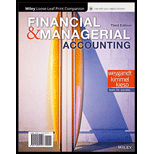
Concept explainers
Elements of
The chief elements of any business include all that it owns and owes. These include assets and liabilities. The resources owned by a business are called assets. The money the company owes to others or creditors are called liabilities. The claims made by the owners are called
Assets
Assets are the resources owned by a business to carry out production and sales activities. The assets are associated with a future economic value that can be expressed in terms of monetary values. All the assets are meant to provide future services or benefits. Examples include cash,
Liabilities
Liabilities are the obligations against assets that are to be fulfilled in the future. Most of the businesses borrow money or buy goods and services from a supplier on credit. This incurs a future obligation on the businesses, which is to be fulfilled in the future. Examples include loans payable, interest payable, accounts payable, wages payable, etc.
Stockholders’ equity
The amount invested to a business by its shareholder or the donated capital and earnings from operations less any dividends issued gives the stockholders’ equity. The stockholders’ equity gives the ownership claim on the total assets of a business. The amount left after satisfying the creditors, belongs to the stockholders’ claim on the assets. It also includes common stock and
The basic accounting equation.
Want to see the full answer?
Check out a sample textbook solution
Chapter 1 Solutions
FINANCIAL&MNGRL ACCT (LL)W//WILEYPLUS>C
- Helparrow_forwardYour boss at LK Enterprises asks you to compute the company's cash conversion cycle. Looking at the financial statements, you see that the average inventory for the year was $135,500, accounts receivable were $102,400, and accounts payable were at $121,700. You also see that the company had sales of $356,000 and that cost of goods sold was $298,500. What is your firm's cash conversion cycle? Round to the nearest day. Correct answerarrow_forwardPlease provide problem with accounting answerarrow_forward
- Answerarrow_forwardFinancial Accounting Question need help with this accounting questionarrow_forwardFor the Crestview Manufacturing Company, the average age of accounts receivable is 50 days, the average age of accounts payable is 40 days, and the average age of inventory is 68 days. Assuming a 365-day year, what is the length of the firm's cash conversion cycle?arrow_forward

 AccountingAccountingISBN:9781337272094Author:WARREN, Carl S., Reeve, James M., Duchac, Jonathan E.Publisher:Cengage Learning,
AccountingAccountingISBN:9781337272094Author:WARREN, Carl S., Reeve, James M., Duchac, Jonathan E.Publisher:Cengage Learning, Accounting Information SystemsAccountingISBN:9781337619202Author:Hall, James A.Publisher:Cengage Learning,
Accounting Information SystemsAccountingISBN:9781337619202Author:Hall, James A.Publisher:Cengage Learning, Horngren's Cost Accounting: A Managerial Emphasis...AccountingISBN:9780134475585Author:Srikant M. Datar, Madhav V. RajanPublisher:PEARSON
Horngren's Cost Accounting: A Managerial Emphasis...AccountingISBN:9780134475585Author:Srikant M. Datar, Madhav V. RajanPublisher:PEARSON Intermediate AccountingAccountingISBN:9781259722660Author:J. David Spiceland, Mark W. Nelson, Wayne M ThomasPublisher:McGraw-Hill Education
Intermediate AccountingAccountingISBN:9781259722660Author:J. David Spiceland, Mark W. Nelson, Wayne M ThomasPublisher:McGraw-Hill Education Financial and Managerial AccountingAccountingISBN:9781259726705Author:John J Wild, Ken W. Shaw, Barbara Chiappetta Fundamental Accounting PrinciplesPublisher:McGraw-Hill Education
Financial and Managerial AccountingAccountingISBN:9781259726705Author:John J Wild, Ken W. Shaw, Barbara Chiappetta Fundamental Accounting PrinciplesPublisher:McGraw-Hill Education





